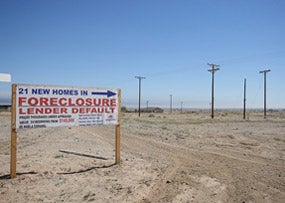 Remember “trickle-down economics?” It’s a very simple idea that first entered the vernacular during the Reagan era. It proposes that government can best stimulate the economy as a whole by taking care of companies and decision-makers at the very top of the economic food chain, by means of tax cuts, government incentives, subsidies and the like. The idea is that such largesse bestowed on the entities and people who create employment will “trickle-down” to the employees and small businesses that depend on the big dogs; thereby giving people more money to spend in our consumer-based economy. It was certainly a popular theory for a while, and why not? Irrespective of what is true, or not, about economics, everyone would love to believe that the interests of the wealthy are perfectly aligned with those of middle and lower income Americans.
Remember “trickle-down economics?” It’s a very simple idea that first entered the vernacular during the Reagan era. It proposes that government can best stimulate the economy as a whole by taking care of companies and decision-makers at the very top of the economic food chain, by means of tax cuts, government incentives, subsidies and the like. The idea is that such largesse bestowed on the entities and people who create employment will “trickle-down” to the employees and small businesses that depend on the big dogs; thereby giving people more money to spend in our consumer-based economy. It was certainly a popular theory for a while, and why not? Irrespective of what is true, or not, about economics, everyone would love to believe that the interests of the wealthy are perfectly aligned with those of middle and lower income Americans.
But whether or not the term is used, everyone who is opposing tax hikes for the rich or closing corporate tax loopholes is really espousing the theory. I come today to neither bury nor praise the “trickle-down” theory. I’m merely suggesting that if the pleasure of government assistance to the corporate sector can trickle-down, so too, perhaps, can the pain.
[Article: Consumers Be Damned: Senator Shelby, Captain Queeg and the Politics of No]
Statistically it’s been a rough couple of weeks. The government reported that the number of people below the poverty line has increased dramatically, that the plague of joblessness continued unabated, that housing prices remained steadfastly weak, and that foreclosures spiked somewhat dramatically in the month of August. For those looking for a silver lining in the current real estate disaster, there was a smidgeon of good news—or was there? Some attributed the uptick in the number of foreclosures to the fact that many financial institutions which had previously halted them altogether as a result of faulty documentation, robo-signing and similar technical obstacles to a smooth process, had begun to lift that freeze. And, that we might be getting back on the road to a more market-driven environment. My take is somewhat different: I think the spike tells you that during the “quiet period,” nothing happened to prevent or at least slow down the epidemic that is causing so many Americans to lose their homes. For example, if housing prices had improved somewhat during the hiatus and left fewer people drowning in underwater mortgages, perhaps there wouldn’t have been so many foreclosures in August. Or, if government or the Fed had come up with a really intelligent and broad-based refinancing plan—one that banks would have been motivated to adopt—maybe some of the defaulting homeowners could have found a way to refinance while the gun was, for a moment at least, not pointed squarely at their temples.
[Featured Tool: Get your free Credit Report Card from Credit.com]
Frankly, I haven’t found anything that gives me an indication that things are improving. If there is a recovery going on, it is one that exists only in the most technical sense. The GDP seems to be growing, however anemically, corporate profits are good, the banks are relatively healthy, and no major European country has defaulted on its sovereign debt—yet. But every economic indicia that is important to the average American continues to deteriorate, or at least not to improve.
As we discussed the week that was, a friend pointed out that I had failed to mention one important announcement that happened last week—credit card debt among individuals had risen sharply. “Isn’t this a good sign?” he asked. “What could be better for the economy than the consumer starting to spend again?” Unfortunately, he may have misread the tea leaves. I think that the consumer spending on credit cards could be a sign of desperation rather than an omen of good times to come.
Here’s what might really be happening. Credit card debt is up because cash-starved unemployed Americans are using what remaining credit they have left on their cards for ordinary household expenses, like utility payments, car payments, or—worst of all—mortgage payments. They just don’t have any money, so they’re doing whatever they can to avoid apocalypse. And now that foreclosures are speeding up again, the 4 million or so American families that are at risk of losing their homes are getting closer and closer to the edge.
[Featured Product: Looking for your credit report?]
How to Fix the Foreclosure Crisis: A Real Bailout (cont.) »
Image: jeroen020, via Flickr.com
You Might Also Like
December 13, 2023
Mortgages







